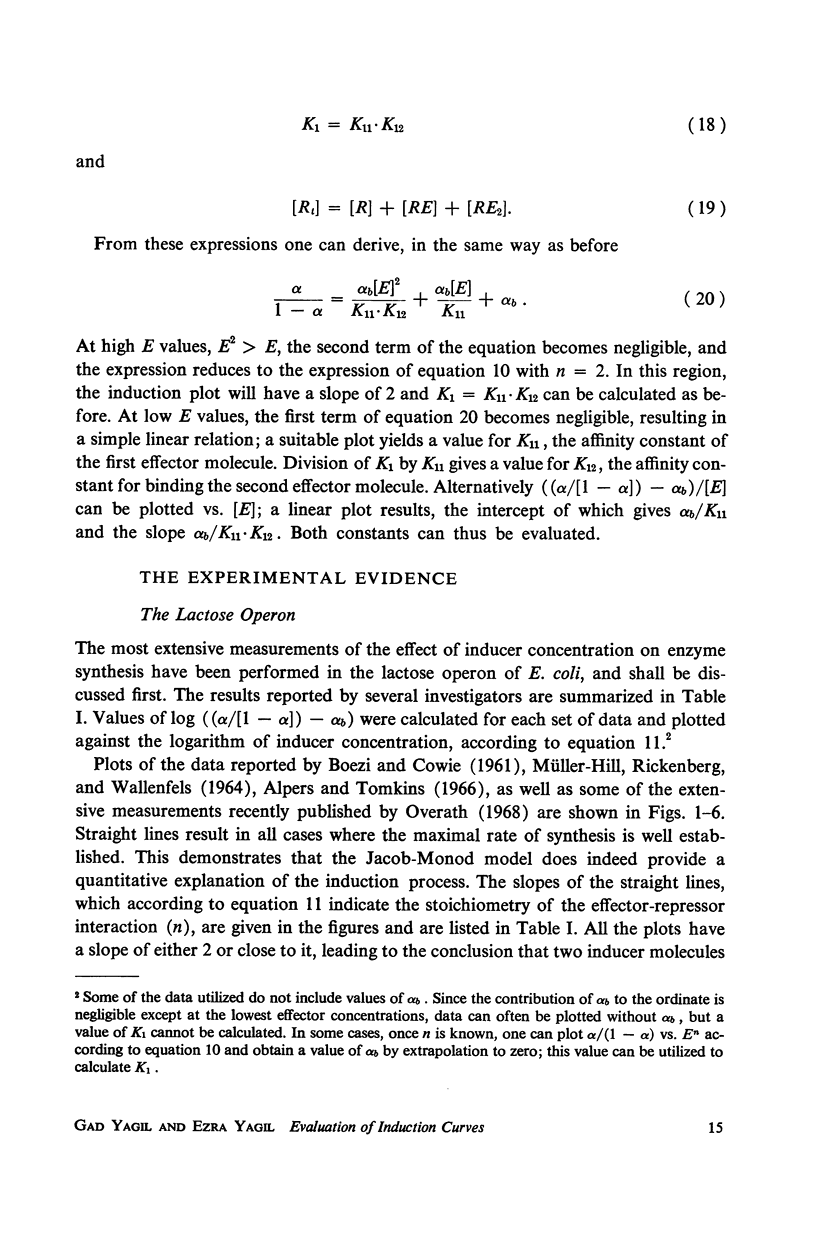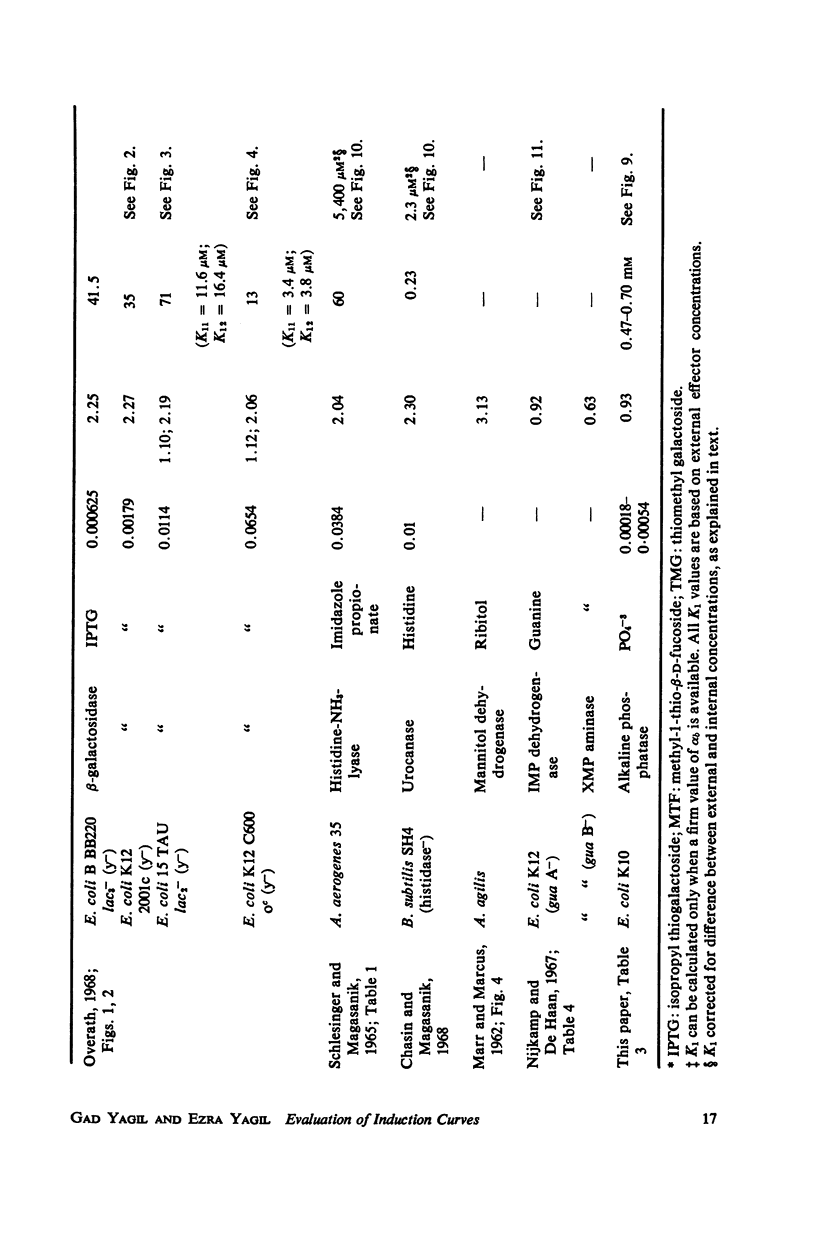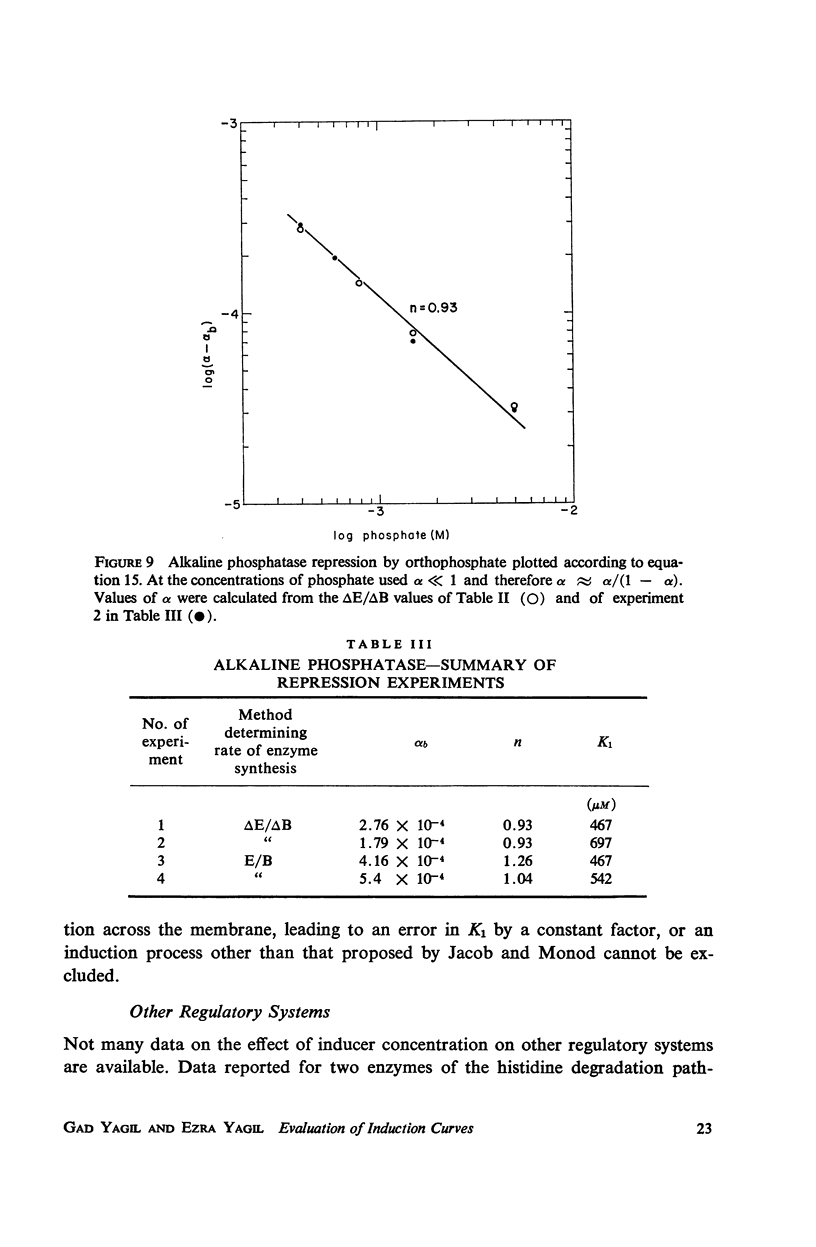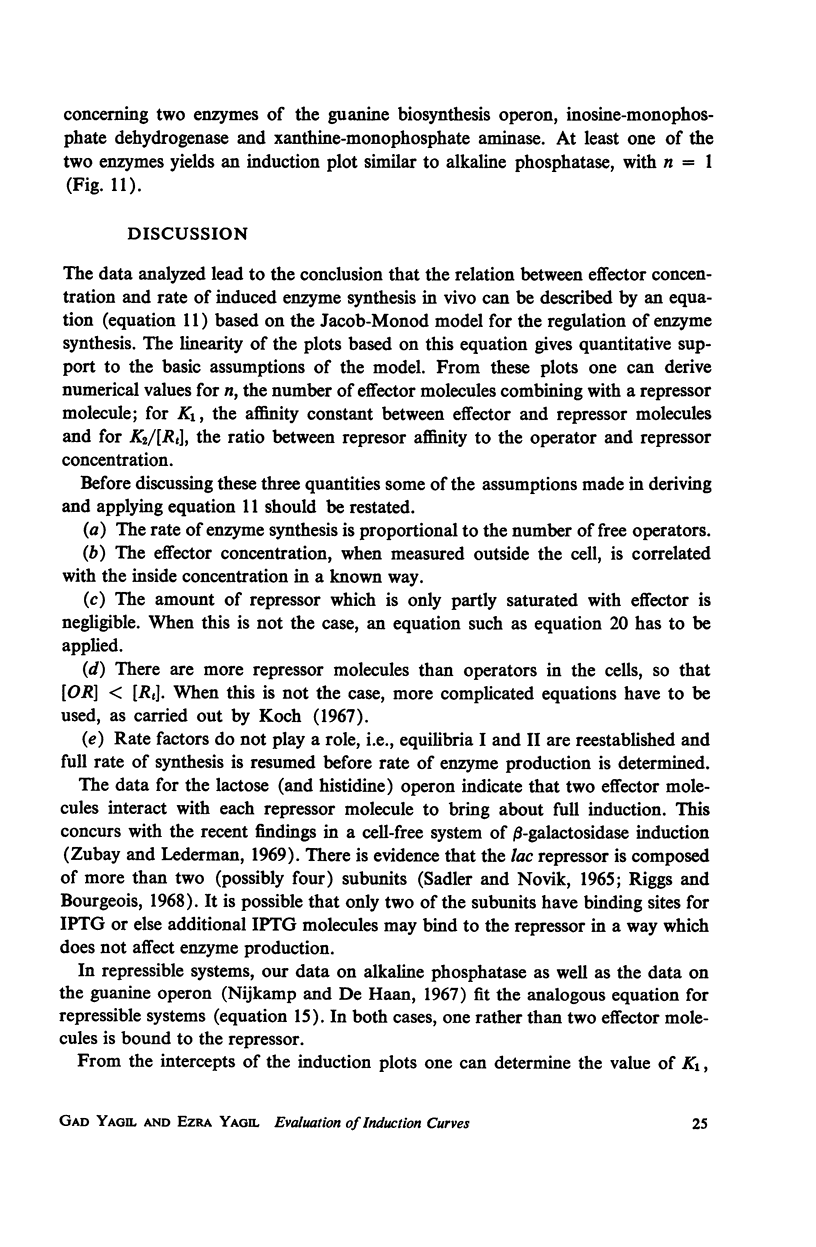Abstract
The Jacob and Monod scheme for the regulation of enzyme formation leads to the following relation between the relative rate of enzyme synthesis α and cellular effector concentration E (the lower sign is for repressible systems): log (α/1 - α - αb) = ± n log [E] + log αb ± log K1. This equation permits linear plotting of experimental data and the evaluation of three quantities: n, the number of effector molecules combining with a repressor molecule, K1, the dissociation constant of this interaction and K2/Rt, the ratio of repressor-operator dissociation constant to total repressor concentration. Measurements on the repression of alkaline phosphatase in Escherichia coli as a function of phosphate concentration are reported and fit the proposed equation with n = 1, indicating that the binding of a single phosphate to the repressor species may be sufficient to cause repression. K1 of this interaction was found to be 0.58 ±0.11 × 10-3 M. The available data regarding the enzymes of the lac operon in a variety of E. coli strains, and several other enzymes are analyzed. It is confirmed that the lac repressor interacts with 2 isopropyl thiogalactoside (IPTG) molecules to relieve repression with a K1 = 50 ±20 × 10-12 M2. In some strains, separate binding constants for the first and second IPTG molecules can be evaluated.
Full text
PDF
















Selected References
These references are in PubMed. This may not be the complete list of references from this article.
- Alpers D. H., Tomkins G. M. Sequential transcription of the genes of the lactose operon and its regulation by protein synthesis. J Biol Chem. 1966 Oct 10;241(19):4434–4443. [PubMed] [Google Scholar]
- BOEZI J. A., COWIE D. B. Kinetic studies of beta-galactosidase induction. Biophys J. 1961 Nov;1:639–647. doi: 10.1016/s0006-3495(61)86913-0. [DOI] [PMC free article] [PubMed] [Google Scholar]
- Chasin L. A., Magasanik B. Induction and repression of the histidine-degrading enzymes of Bacillus subtilis. J Biol Chem. 1968 Oct 10;243(19):5165–5178. [PubMed] [Google Scholar]
- ECHOLS H., GAREN A., GAREN S., TORRIANI A. Genetic control of repression of alkaline phosphatase in E. coli. J Mol Biol. 1961 Aug;3:425–438. doi: 10.1016/s0022-2836(61)80055-7. [DOI] [PubMed] [Google Scholar]
- GAREN A., ECHOLS H. Genetic control of induction of alkaline phosphatase synthesis in E. coli. Proc Natl Acad Sci U S A. 1962 Aug;48:1398–1402. doi: 10.1073/pnas.48.8.1398. [DOI] [PMC free article] [PubMed] [Google Scholar]
- GAREN A., ECHOLS H. Properties of two regulating genes for alkaline phosphatase. J Bacteriol. 1962 Feb;83:297–300. doi: 10.1128/jb.83.2.297-300.1962. [DOI] [PMC free article] [PubMed] [Google Scholar]
- Gilbert W., Müller-Hill B. Isolation of the lac repressor. Proc Natl Acad Sci U S A. 1966 Dec;56(6):1891–1898. doi: 10.1073/pnas.56.6.1891. [DOI] [PMC free article] [PubMed] [Google Scholar]
- Gilbert W., Müller-Hill B. The lac operator is DNA. Proc Natl Acad Sci U S A. 1967 Dec;58(6):2415–2421. doi: 10.1073/pnas.58.6.2415. [DOI] [PMC free article] [PubMed] [Google Scholar]
- HARTWELL L. H., MAGASANIK B. THE MECHANISM OF HISTIDASE INDUCTION AND FORMATION IN BACILLUS SUBTILIS. J Mol Biol. 1964 Oct;10:105–119. doi: 10.1016/s0022-2836(64)80031-0. [DOI] [PubMed] [Google Scholar]
- HERZENBERG L. A. Studies on the induction of beta-galactosidase in a cryptic strain of Escherichia coli. Biochim Biophys Acta. 1959 Feb;31(2):525–538. doi: 10.1016/0006-3002(59)90029-0. [DOI] [PubMed] [Google Scholar]
- JACOB F., MONOD J. Genetic regulatory mechanisms in the synthesis of proteins. J Mol Biol. 1961 Jun;3:318–356. doi: 10.1016/s0022-2836(61)80072-7. [DOI] [PubMed] [Google Scholar]
- KEPES A. [Kinetic studies on galactoside permease of Escherichia coli]. Biochim Biophys Acta. 1960 May 6;40:70–84. doi: 10.1016/0006-3002(60)91316-0. [DOI] [PubMed] [Google Scholar]
- Koch A. L. The tight binding nature of the repressor-operon interaction. J Theor Biol. 1967 Aug;16(2):166–186. doi: 10.1016/0022-5193(67)90003-3. [DOI] [PubMed] [Google Scholar]
- LOWRY O. H., ROBERTS N. R., LEINER K. Y., WU M. L., FARR A. L. The quantitative histochemistry of brain. I. Chemical methods. J Biol Chem. 1954 Mar;207(1):1–17. [PubMed] [Google Scholar]
- MONOD J., PAPPENHEIMER A. M., Jr, COHEN-BAZIRE G. La cinétique de la biosynthèse de la beta-galactosidase chez E. coli considérée comme fonction de la croissance. Biochim Biophys Acta. 1952 Dec;9(6):648–660. doi: 10.1016/0006-3002(52)90227-8. [DOI] [PubMed] [Google Scholar]
- MUELLER-HILL B., RICKENBERG H. V., WALLENFELS K. SPECIFICITY OF THE INDUCTION OF THE ENZYMES OF THE LAC OPERON IN ESCHERICHIA COLI. J Mol Biol. 1964 Nov;10:303–318. doi: 10.1016/s0022-2836(64)80049-8. [DOI] [PubMed] [Google Scholar]
- Müller-Hill B., Crapo L., Gilbert W. Mutants that make more lac repressor. Proc Natl Acad Sci U S A. 1968 Apr;59(4):1259–1264. doi: 10.1073/pnas.59.4.1259. [DOI] [PMC free article] [PubMed] [Google Scholar]
- Nijkamp H. J., De Haan P. G. Genetic and biochemical studies of the guanosine 5'-monophosphate pathway in Escherichia coli. Biochim Biophys Acta. 1967 Aug 22;145(1):31–40. doi: 10.1016/0005-2787(67)90651-x. [DOI] [PubMed] [Google Scholar]
- Overath P. Control of basal level activity of beta-falactosidase in Escherichia coli. Mol Gen Genet. 1968;101(2):155–165. doi: 10.1007/BF00336581. [DOI] [PubMed] [Google Scholar]
- PARDEE A. B., PRESTIDGE L. S. The initial kinetics of enzyme induction. Biochim Biophys Acta. 1961 Apr 29;49:77–88. doi: 10.1016/0006-3002(61)90871-x. [DOI] [PubMed] [Google Scholar]
- Richmond M. H. Enzymic adaptation in bacteria: its biochemical and genetic basis. Essays Biochem. 1968;4:105–154. [PubMed] [Google Scholar]
- Riggs A. D., Bourgeois S., Newby R. F., Cohn M. DNA binding of the lac repressor. J Mol Biol. 1968 Jul 14;34(2):365–368. doi: 10.1016/0022-2836(68)90261-1. [DOI] [PubMed] [Google Scholar]
- Riggs A. D., Bourgeois S. On the assay, isolation and characterization of the lac repressor. J Mol Biol. 1968 Jul 14;34(2):361–364. doi: 10.1016/0022-2836(68)90260-x. [DOI] [PubMed] [Google Scholar]
- Rothman F., Coleman J. R. Kinetics of transcription and tranalation of a repressed gene. J Mol Biol. 1968 Apr 28;33(2):527–531. doi: 10.1016/0022-2836(68)90212-x. [DOI] [PubMed] [Google Scholar]
- SADLER J. R., NOVICK A. THE PROPERTIES OF REPRESSOR AND THE KINETICS OF ITS ACTION. J Mol Biol. 1965 Jun;12:305–327. doi: 10.1016/s0022-2836(65)80255-8. [DOI] [PubMed] [Google Scholar]
- Schlesinger S., Magasanik B. Imidazolepropionate, a nonmetabolizable inducer for the histidine-degrading enzymes in Aerobacter aerogenes. J Biol Chem. 1965 Nov;240(11):4325–4330. [PubMed] [Google Scholar]
- TORRIANI A. Influence of inorganic phosphate in the formation of phosphatases by Escherichia coli. Biochim Biophys Acta. 1960 Mar 11;38:460–469. doi: 10.1016/0006-3002(60)91281-6. [DOI] [PubMed] [Google Scholar]
- Zubay G., Lederman M. DNA-directed peptide synthesis. VI. Regulating the expression of the lac operon in a cell-free system. Proc Natl Acad Sci U S A. 1969 Feb;62(2):550–557. doi: 10.1073/pnas.62.2.550. [DOI] [PMC free article] [PubMed] [Google Scholar]


